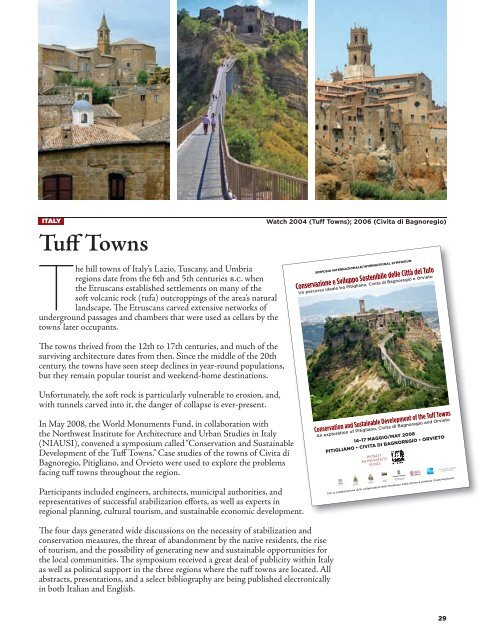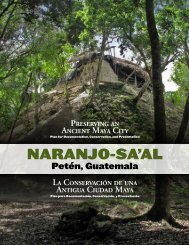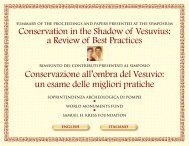2008 Annual Report - World Monuments Fund
2008 Annual Report - World Monuments Fund
2008 Annual Report - World Monuments Fund
You also want an ePaper? Increase the reach of your titles
YUMPU automatically turns print PDFs into web optimized ePapers that Google loves.
italy<br />
Tuff Towns<br />
The hill towns of Italy’s Lazio, Tuscany, and Umbria<br />
regions date from the 6th and 5th centuries b.c. when<br />
the Etruscans established settlements on many of the<br />
soft volcanic rock (tufa) outcroppings of the area’s natural<br />
landscape. The Etruscans carved extensive networks of<br />
underground passages and chambers that were used as cellars by the<br />
towns’ later occupants.<br />
The towns thrived from the 12th to 17th centuries, and much of the<br />
surviving architecture dates from then. Since the middle of the 20th<br />
century, the towns have seen steep declines in year-round populations,<br />
but they remain popular tourist and weekend-home destinations.<br />
Unfortunately, the soft rock is particularly vulnerable to erosion, and,<br />
with tunnels carved into it, the danger of collapse is ever-present.<br />
In May <strong>2008</strong>, the <strong>World</strong> <strong>Monuments</strong> <strong>Fund</strong>, in collaboration with<br />
the Northwest Institute for Architecture and Urban Studies in Italy<br />
(NIAUSI), convened a symposium called “Conservation Conservation and Sustainable<br />
Development of the Tuff Towns.” Case studies of the towns of Civita di<br />
Bagnoregio, Pitigliano, and Orvieto were used to explore the problems<br />
facing tuff towns throughout the region.<br />
Participants included engineers, architects, municipal authorities, and<br />
representatives of successful stabilization efforts, as well as experts in<br />
regional planning, cultural tourism, and sustainable economic development.<br />
The four days generated wide discussions on the necessity of stabilization and<br />
conservation measures, the threat of abandonment by the native residents, the rise<br />
of tourism, and the possibility of generating new and sustainable opportunities for<br />
the local communities. The symposium received a great deal of publicity within Italy<br />
as well as political support in the three regions where the tuff towns are located. All<br />
abstracts, presentations, and a select bibliography are being published electronically<br />
in both Italian and English.<br />
Watch 2004 (Tuff Towns); 2006 (Civita di Bagnoregio)<br />
SimpoSio internazionale/international SympoSium<br />
Conservazione e Sviluppo Sostenibile delle Città del Tufo<br />
Un percorso ideale tra Pitigliano, Civita di Bagnoregio e Orvieto<br />
Conservation and Sustainable Development of the Tuff Towns<br />
An exploration of Pitigliano, Civita di Bagnoregio and Orvieto<br />
14–17 maggio/may <strong>2008</strong><br />
pitigliano • Civita di Bagnoregio • orvieto<br />
Comune di<br />
Bagnoregio<br />
Comune di<br />
Pitigliano<br />
Comune di<br />
Orvieto<br />
Assessorato Ambiente e<br />
Sviluppo Sostenibile<br />
Con la collaborazione di/In collaboration with: Professor Astra Zarina & Anthony Costa Heywood<br />
29
















